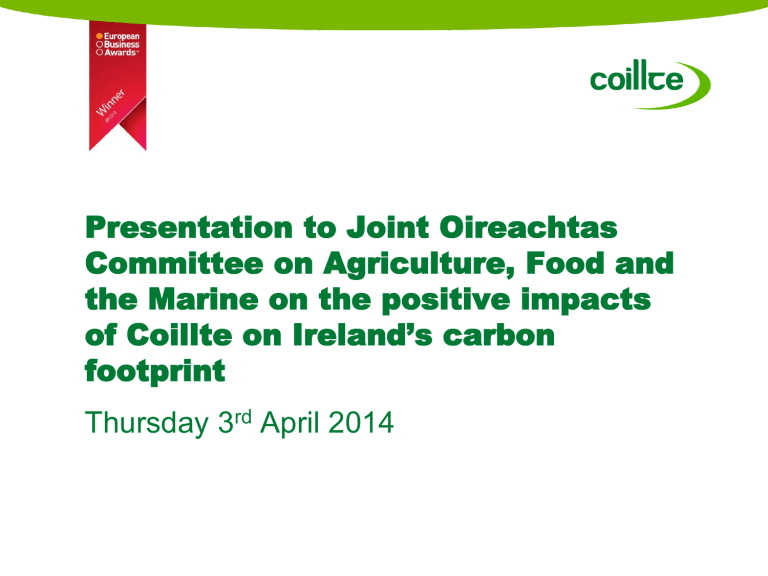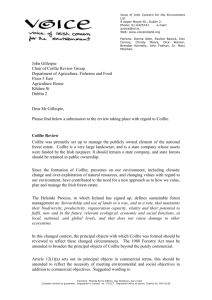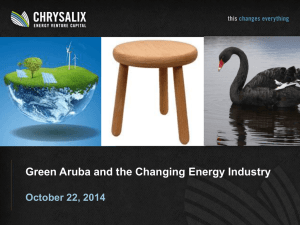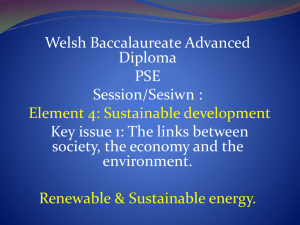Presentation by Coillte on Land Use 030414

Presentation to Joint Oireachtas
Committee on Agriculture, Food and the Marine on the positive impacts of Coillte on Ireland’s carbon footprint
Thursday 3 rd April 2014
Coillte has stewardship over
7% of land area of Ireland
1
Coillte can deploy its natural resources to reduce carbon emissions providing headroom for growth in agriculture
Carbon
Sequestration
Renewable Energy Low Carbon Building
Products
2
Forestry and its role in reducing Ireland’s carbon footprint
3
Our Forests –
Scale of Operations
Sell 2.4 million m 3 of roundwood
Reforest 6,000ha using 15 million trees each year
Maintain 9,500kms of forest roads
Receive 18 million recreational visits to our forests per year
Manage 20% of our estate to protect and enhance biodiversity
Certified by FSC
Seeking PEFC & ISO14001 certification in 2014
Our BAUs work with approx 460 individual contractors employing circa
1300 people across the country
4
Our Forests -
Strategy 2018
Being more efficient
Unlocking the potential of private timber
Increased
Forest
Value
Being smarter at what we do
Creating awareness and recognition for public goods
Building on the customer experience
5
Our Forests
- Role in Carbon agenda
Carbon Sequestration
Forest
Area
Expansion
Increased
Productivity
6
Our Forests
– Thinking Green
Independent research has evaluated the economic impact of
Public Goods Coillte provides:
Nature conservation and biodiversity -
€322m per annum *
Cultural Heritage €92m per annum *
Landscape protection
– €96m per annum *
Recreation – €97m per annum
Generating
€270m of economic activity in local communities
* Source
– Valuation of the public goods – landscape, habitats and species, and cultural heritage – provided by the Coillte Estate
– Goodbody Economic Consultants
7
Other contributions to reducing Ireland’s carbon footprint from the Coillte estate
8
Managing land to add value
Coillte manages two great assets - forests & land
Our objective as stewards of the land is to look for other benefits the land can provide, where it is not suitable for forestry
These uses include renewable energy, biomass, telecoms mast sites and infrastructure projects
9
Land – A Key Natural Resource
6,000 Discrete Properties
Valuable Attributes
10
Why Renewables?
2009 EU Renewables Directive
Dependence on imported fossil fuels
Climate change
Economics
11
Renewable Energy – Our Role to Date
- Renewables = 2,000MW
- Renewables @ 20%
- Coillte enabled 40%
- Areas we are involved:
Windfarms
Connections
ESB Networks
Eirgrid
12
Renewable Energy - Our Future
Role
Develop our own 500MW portfolio in conjunction with our partner
Support others in delivery of projects and infrastructure in support of Ireland’s RES-E ambition
Provide leadership in relation to community engagement and community gain
Support the concept of an export project for renewable energy, in line with Government policy
Provide advocacy for maximum deployment of wind energy solutions in a macro economic context
13
Biomass as a Renewable
Energy Source
14
Ireland RES-H Progress
Current level = 5.2%
Target = 12%
An incentive mechanism can provide the solution
Solution = A Renewable Heat Incentive
A payment system for the generation of heat from renewable energy sources, similar to a REFIT scheme for electricity.
15
Benefits of a Renewable Heat
Incentive
Reducing our reliance on fossil fuels and reducing greenhouse gas emissions
Help offset emissions in other sectors e.g. agriculture
Improve competitiveness of industry
Stimulate rural development and employment
Provide a market for the private timber resource
Reduce level of future fines
16
Case Study :
Astellas Ireland Ltd. Co. Kerry
17
Land – Adding Value, Benefiting
Many
18
In conclusion….
By deploying our natural resource assets we can deliver:
increased carbon sequestration from our forests;
low carbon energy efficient building products;
confidence for landowners who wish to plant new land that an efficient supply chain is in place;
renewable energy from wind and biomass.
19
In conclusion….
Recommendations which could further enhance our ability to contribute:
a Renewable Heat Incentive to encourage the growth of bioenergy;
clear signal of the Government’s ambition for wind energy post 2020 (both domestic and export);
recognition for the provision of valuable public goods.
Thank you for your attention
20








